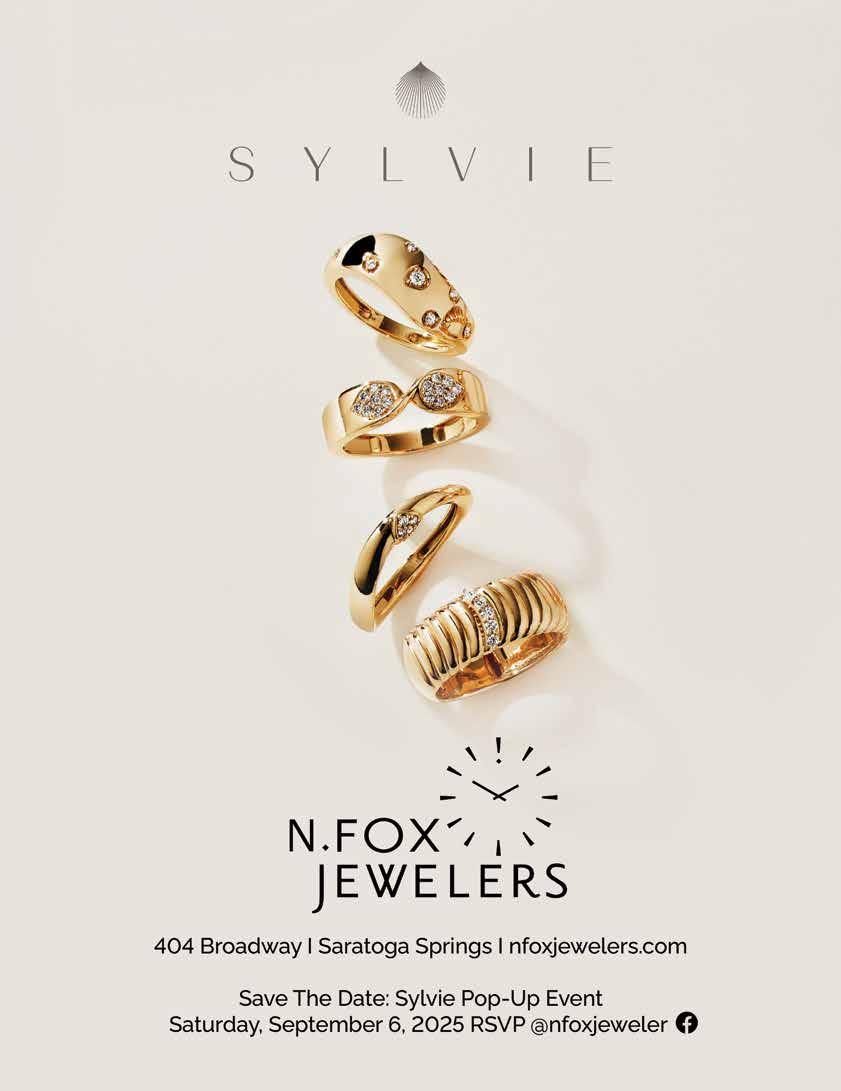









Marion E. Altieri, EDITORIAL DIRECTOR











Marion E. Altieri, EDITORIAL DIRECTOR
We have a lot on-deck to entice you, so let’s get to it!
• The Belmont Stakes is always thrilling – whether hosted here in Saratoga, or on Long Island. As we host the big race again, we’ll see world-class Thoroughbreds gracing our unique oval. As of this printing, Bill Mott, Trainer of Sheikh Mohammed’s Sovereignty, who won the Kentucky Derby on the First Saturday in May, plans to enter the big, gorgeous Bay in the Belmont. (We wonder how many others will dare go up against him?)
• It’s our hope that you enjoy this Belmont issue, including the feature section on f!llies and mares. (Approximately 45% of all Thoroughbreds racing on any given track are females; we hope to do right by them in this issue.) Our ace Writers will highlight famous females from North America, Australia, Hong Kong, Japan, Europe – in essence, the world. You may see your favorites herein – and learn about others worthy of your admiration!
• World-renowned American Impressionist Artist, Lisa Palombo, will mount her show, Famous Fillies, at Spa Fine Art. The official Opening will be July 31st, and go through the race meet. (Prior to that, folks in town for the Belmont weekend can view some of the works on June 6th.)
• In 1966, The Association sang, And Along Comes Mary – a title we think is perfectly appropriate for our piece on Mary Hirsch, the first female to be licensed as a Thoroughbred Trainer in America.
• Cocktails, Fashion, Dining and other enjoyments will get their fair share of space, and –
• Last, and certainly weirdest: before Hoffa my have been buried beneath a famous stadium (maybe?), the man was involved in a scandal swirling about horse racing. (Of course.)
Read on, O Race Fans – there’s something for everyone in this Equicurean Belmont 2025. We hope you love it, as much as we loved making it for you.

OWNER/PUBLISHER
Chad Beatty
EDITORIAL DIRECTOR
Marion E. Altieri
MAGAZINE DESIGNER
Kacie Cotter-Harrigan
ADVERTISING DESIGN
Julia Ettkin
ADVERTISING SALES
Chris Vallone Bushee
Jim Daley
Cindy Durfey
CONTRIBUTING WRITERS
Marion E. Altieri
L.A. Berry
Matt Bonk
Taylor Flynn
Carol Godette
William G. Gotimer Jr.
Bill Orzell
Stewart White
PHOTOGRAPHERS
Robin Ann Barry
Mike F. Campbell
Adam Coglianese / NYRA
Cathleen Duffy
Taylor Flynn
Rudolph A. Furtado
Janet Garaguso / NYRA
Cherry He
Keeneland Library Cook Collection
Jim McCue / Maryland Jockey Club
National Museum of Racing and Hall of Fame Collection
Susie Raisher / NYRA
MJ Sibbitt
William Strode
Super Source Media Studios
Nicole Thomas / NYRA
Ryan Thompson / NYRA
Andrew Watkins / Dubai Racing Club
Walter Wlodarczyk / NYRA
Ray Woolfe, Jr.
PUBLISHED BY
2254 Route 50 South
Saratoga Springs, NY 12866
518-581-2480
saratogaTODAYnewspaper.com
Equicurean® is brought to you by Saratoga TODAY, Saratoga Publishing, LLC. Saratoga Publishing shall make every effort to avoid errors and omissions but disclaims any responsibility should they occur. No part of this publication may be reproduced, stored in a retrieval system, or transmitted in any form or by any means without prior written consent of the publisher. Copyright © 2025. Saratoga TODAY Newspaper.




Named one of the world's greatest sporting venues, tradition comes alive at Saratoga Race Course. With historical ambiance and modern amenities and style, Saratoga Race Course is the place to find prime Thoroughbred horse racing, drawing the top horses, trainers and owners in the world to try their luck at "The Spa."

“From New York City you drive north for about 175 miles, turn left on Union Avenue and go back 100 years."
-Red Smith Sportswriter (1905-1982)




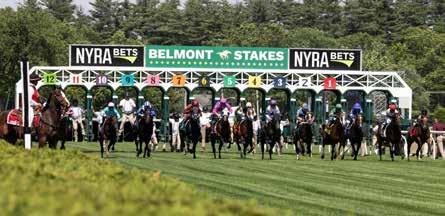
5:30 – 7:30 PM (VIP: 5 – 5:30 PM) UNIVERSAL PRESERVATION HALL
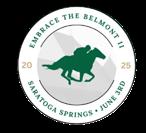
Embrace the Belmont II brings the Saratoga Springs year-round community together to learn basic handicapping and explore the 2025 Belmont Stakes field. This event helps local business owners, professionals, and residents deepen their understanding of horse racing, so you’ll feel prepared to not only embrace the Belmont Racing Festival but also feel capable of discussing this year’s Belmont Stakes field with an aura of expertise.
7-10 PM
Belmont on Broadway, a free concert, is slated for June 4, from 7-10 p.m. with performances by Gin Blossoms and Uprooted to take place on Broadway in Saratoga Springs. Broadway will be closed from Van Dam to City Hall most likely all day Wednesday starting early in the morning to install the stage.
Taking place on Saturday, June 7, the 157th edition of this prestigious event is part of the Belmont Stakes Racing Festival, spanning Wednesday, June 4 to Sunday, June 8. The five-day Festival at Saratoga Race Course will include 25+ stakes races with the richest purses since the launch of the multi-day Belmont Stakes Racing Festival in 2014.

Belmont Gala at Canfield Casino
7-11 PM
Celebrate the Belmont Stakes festival in Saratoga Springs at the Canfield Casino with the National Museum of Racing and Hall of Fame! This evening will feature fine dining, live music, and a celebration of incredible sportsmanship.
Ticket Link: National Museum of Racing and Hall of Fame

JUNE 7

Saturday Morning Social
9 A.M. TO 11 A.M.
NATIONAL MUSEUM OF RACING AND HALL OF FAME
This event is a FREE, open-house style event! Join us for a Saturday Morning Social at the National Museum of Racing and Hall of Fame! Enjoy a Belmont Stakes poster signing with artist Greg Montgomery and a handicapping seminar. A fun and interactive morning celebrating the art, sport, and excitement of thoroughbred racing right on Belmont Stakes Day! Coffee and donuts provided by Stewart's Shops!

6
SARATOGA PAINT N SIP
Come celebrate the opening of the 2025 Saratoga Race Course and the Belmont Stakes with this colorful horse. No experience necessary. Our artists are the best teachers around! info@saratogapaintandsip.com
8
NATIONAL MUSEUM OF RACING AND HALL OF FAME
10 A.M. TO 2 P.M
Join us as we turn the Museum into a carnival, complete with fun games, delicious food, and thrilling entertainment! Here's just a preview of what we have in store:
Jump and soar in our thrilling bounce houses and slides! Enjoy complimentary ice cream, popcorn, and cotton candy! See astonishing magical feats from the spectacular Mr. Twisty! Conquer our towering rock climbing wall! Meet our colorful menagerie of animals!
This family-friendly event is FREE to attend, and perfect for kids of all ages.

JUNE 4-8
The five-day Belmont Stakes Racing Festival will include 25+ stakes races at Saratoga Race Course. The 2025 Belmont Stakes will run on Saturday, June 7.
WEDNESDAY, JUNE 4th



THURSDAY, JUNE 5th
FRIDAY, JUNE 6th




SATURDAY,
SUNDAY,

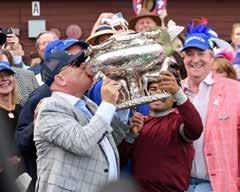


The July 4th Racing Festival will run from Thursday, July 3 - Sunday, July 6 at Saratoga Race Course. The weekend will close out on Sunday, July 6 with no stakes races scheduled.
THURSDAY,
FRIDAY,
SATURDAY,
PHOTO BY ADAM COGLIANESE / NYRA

All racehorses celebrate their birthday on the same day. Regardless of what date they were born on, each Thoroughbred turns a year older on Jan. 1 in the Northern Hemisphere or Aug. 1 in the Southern Hemisphere, for ease of grouping them by age for racing and training.
An average racehorse weighs around a half-ton (1,000 pounds).
Thoroughbreds can trace their lineage to three “foundation” sires of the 17th century: the Byerley Turk, the Darley Arabian, and the Godolphin Arabian. Each sire was brought to England from the Middle East, and their offspring ultimately resulted in the Thoroughbred we know today.
Racehorse names must be approved by the breed registry. In the U.S. the Thoroughbred registry is The Jockey Club, and each name must follow certain rules, such as maximum number of characters.
The quickest that a 1 ¼ mile race, the “classic” distance of the Kentucky Derby and other marquee races in the U.S., has been completed in is 1:57.16. The record was set on the grass (rather than a dirt course) by a horse named Red Giant at Santa Anita Park in 2008.
Thoroughbred hooves, like those of all horse breeds, are made of the same protein as fingernails: keratin.
A racehorse is born after an 11-month gestation. Foals weigh around 100 pounds and stand to nurse within hours of being born.
A Thoroughbred can top out at more than 40 mph when racing, though they usually don’t sustain top speed for the entire race but try to reserve it for the stretch run before the finish.
Promising (and established) racehorses can sell for millions of dollars. The most expensive Thoroughbred ever sold at public auction was an unraced 2-year-old later named The Green Monkey, who was bought for $16 million but would never win a race.
A racehorse can consume 20 pounds of food or more, plus 13 gallons of water every day. 1 2 3 4 5 6 7 8 9 10

Since you’re visiting, and I’m lucky enough to live here…
I’ll take you through how I spend an ideal Saturday as a Saratoga Local who loves to eat, shop, and take advantage of everything the city has to offer!
Since my best friend lives downtown, we try to get together on Saturday mornings to catch up, and the best way to do that is over coffee – hot or iced! Looking for a cozy place with an abundance of fun flavors – this is a great option!
With coffee in tow, we head over to Yoga Mandali for a Flow class before heading to the Saratoga Farmers’ Market - this is one of those MUST DO things while you’re here!
Thinking about what to do after we grab a bite… tennis at East Side Rec? Hit some golf balls at The Bunker? or the Kayak Shak on Saratoga Lake?


11:30 AM 2 PM
I find any excuse to come here, and luckily, there’s plenty of them! Walking distance from Broadway, Franklin Square Market is a restaurant and a grocery store and has tons of readymade hot and cold food. This may be a crazy statement, but I’m not the biggest fan of breakfast foods, although I could be convinced to go to Sweet Mimi’s for a Belgian waffle with gelato or Thorn + Roots for a smoothie bowl; I prefer brunch since it gives me the option to get lunch food if that’s what I’m craving, specifically at The Merc or The Saratoga Winery. The Market’s Buffalo Chicken Panini hit the spot. My friend got pizza, salad, and a delicious Nutella Bomboloni from the bakery. Since we ate on the West Side, we had to walk Beekman for a bit before heading back Downtown – so much to do over there!



There are a ton of small shops Downtown that I love to pop into. My friend and I are huge bookworms and usually wind up at Northshire at some point. Today, I was on the hunt for a cute picture book as part of a baby shower gift, and I knew the kids’ floor would be the perfect place to look. They have gifts, games, records, calendars, and books of every genre and reading level. I’m not going to lie, since I work a street over, I sometimes take part of my lunch break to stop in and read in one of their incredibly comfortable chairs.

3:30 PM


Chocolate-covered Oreos are a need, not a want, and I refuse to believe anyone who tells me differently! Kilwins is right next door to Northshire, granting me the opportunity that I will always take to grab all things sweet. Their homemade ice cream is my go-to after-dinner treat in the summer, and their caramel apples are my favorite fall snack. I grabbed my Oreos for later and some chocolate-covered pretzels for my mom – who I’m meeting in thirty minutes! It’s looking like it might rain, so plans have changed.

This restaurant is great for lunch or dinner, and even though it’s affiliated with Druthers and you can still get their iconic beer cheese and wings, the menu is quite different from their Broadway location. I met my mom here for some girl time, hanging in the Adirondack Chairs. We love sitting out here and watching the boats float by. Since I just ate a sandwich, we decided to order some drinks and an appetizer. I usually always get the Miami Vice but I tried the Peanut Butter Espresso Martini - mom got a beer. Their menu is always changing, and I love the Mexican street corn dip they offer for the summer months. Since we had some time to kill before our dinner reservations, we headed back to Broadway and rented bikes at the Visitors Center. A quick trip around the state park – with a stop on the bridge on to watch the geyser was perfect before dinner.


6:30 PM
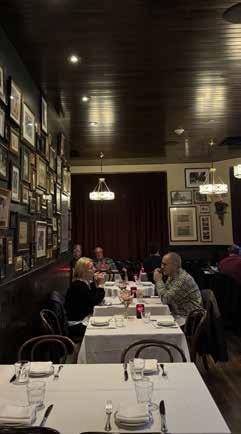
Speaking of dinner, as if we hadn’t eaten enough already, we were actually looking forward to dinner - at our favorite restaurant in Saratoga! As proud Italians, we’re always craving calamari and chicken parm, and Solevo’s Sunday Sauce is incredible. The restaurant is intimate and traditional, with pictures all over the walls like at The Ripe Tomato, where we eat almost every week. For Italian food, Forno and Mamma Mia’s are excellent as well. My mom and aunt head to Ben & Jerry’s down the street, and I meet my boyfriend for a drink.


I used to love the crowded and lively bars on Caroline Street when I was in college, however I’m happy to see more relaxed sit-down places popping up. I love Bibulous because it reminds me of Lucy’s on Caroline Street except with a lot more seating. The drinks are delicious, and the menu also offers snacks and desserts that I’m dying to go back and try… every single one! Even if you’re planning on heading to City Tavern, Night Owl, or Misfit, this would be an awesome place to start the night or hit up after dinner.


11 PM 9:30 PM

I don’t think I’ve ever sat at a table here, because the bar is the main attraction at this restaurant. They have the most colorful, unique drinks, and their bao buns and ramen are amazing. Like most places, the drink menu is seasonal, and I got “The Monarch” with tequila, pear liqueur, lemon, and orange. As locals, we take advantage of hopping around to the more popular bars and restaurants in the spring before track season, when the city is much busier. In July and August, we usually plan ahead and make reservations if we want to go out in Saratoga.


We ended the night at Vapor, a super fun venue where our favorite local band sometimes plays. Located inside the Saratoga Casino, there’s a separate room with a stage, dance floor, balcony area, and bar where bands and DJs perform almost every Friday and Saturday night. It’s a nice option if you want to avoid the crowds yet still hear live music. I’m not a gambler, but there are plenty of slot machines and electronic table games in the building if you want to continue to try your luck after betting on the horses next door.
When we finally head home a little after midnight, I was exhausted and ready for a chill Sunday.

WRITTEN BY MARION E. ALTIERI
When buyers of Thoroughbreds consider a horse for purchase, one of the key considerations is conformation. Conformation is the way a horse is physically put together. The bones, muscles and proportions of the animal are the characteristics that ultimately prepare them for their job—that of running quickly with great efficiency. Human beauty is relative—every culture and every individual has standards of beauty that may not jive with those of anyone else. Everyone is beautiful to somebody.
This is not the case in the equine world: each breed has standards of beauty. That beauty is not superficial, but rather tied directly at the unconscious level to expectations for the jobs of horses within said breed. Draft horses work hard for a living: they are stocky and muscular, with thick legs and strong backs. Thoroughbreds must be able to run fast, with grace, for grace of movement actually is a factor in the science of winning races.
Long, elegant strides are the domain of those who win purses, while jackrabbit runners are far-less likely to take the day. This is a most egalitarian concept: a Thoroughbred doesn’t win a race because s/ he is liked better by the stewards or race announcer. No one votes on who should win — or the Triple Crown would be achieved every year.
A Thoroughbred must cross the finish line first to win a race.
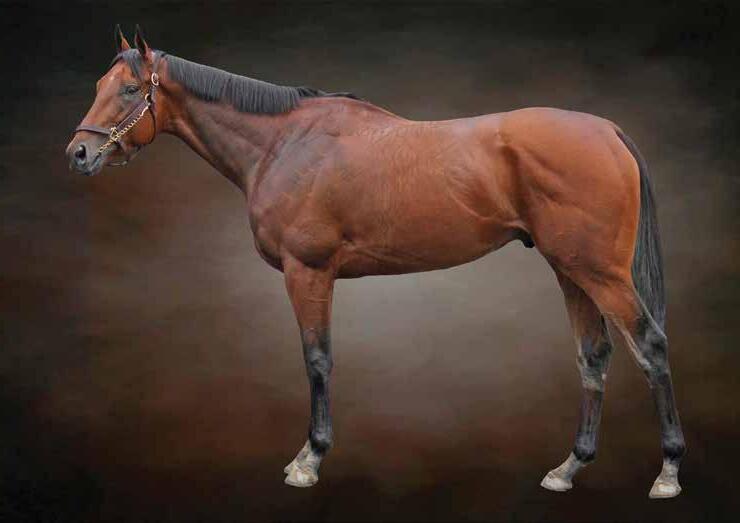
By Georgia Rush / Talk of the Track
And just as Fasig-Tipton’s elegant, renovated facilities are both magnificently lovely and serve a very practical purpose—the two concepts are inextricably bound up together—concern for equine conformation also is a matter of form follows function.
Whether a horse’s main function is to run fast in order to win a race or to escape predators in the wild west— its form has been “fearfully and wonderfully made” to accommodate that most basic of instincts.
The machinery that gives a Thoroughbred his locomotion—the self-powered, patterned motion of limbs or other anatomical parts—is vitally essential, from the core. A horse may be appealing to the eye, but if the parts aren’t hung together in a way that facilitates smooth action and a long stride—beauty means nothing. The legs, hind end, neck, withers and abdomen all must work together like a machine, creating a rhythm that is easily maintained, right ‘til the end of the race. The runners may speed up in the stretch, but the original stride and way of moving of each horse remains essentially the same.
Many factors go into the study of conformation: yes, it’s about musculature; skeletal structure and mass. But it’s the way those physical attributes come together with the spirit of the horse—that one unquantifiable factor— that determines the horse’s chances of becoming a champion. Energy must overcome drag, inertia and gravity, and that is achieved by the mechanical workings of the biological attributes of the horse. Even the fact that horses are unguligrade—they are of a class of animals who walk and run on their toes—is a contributor to the relative perfection of the animal. Of course, horses lacking excellent conformation have made monster names for themselves in the sport: Seabiscuit was small, somewhat boney and was over at the knees. The mighty Seattle Slew actually was slewfooted: when he walked, his right-front hoof turned out. He ran straight as a string, but as soon as he walked back off the track, that right hoof turned and faced East. Both Seabiscuit and Seattle Slew established themselves in the Pantheon of Thoroughbred racing, their conformational flaws notwithstanding.
Secretariat, the mighty warrior who won the Belmont— and therefore, the Triple Crown—by an otherworldly 31 lengths—is considered by most to be the most perfectlyconformed Thoroughbred.
The measuring stick for conformation: a perfect square should be formed by its legs, back and distance between the hooves. A distasteful thought, but if you can envision a Thoroughbred with its head cut off at the neck — that squareness, or lack thereof, will be revealed. Secretariat formed a perfect square, to the naked eye using that yardstick.

Indeed, Secretariat was as perfect as possible, and no doubt, our recent Triple Crown winner, American Pharoah, also will be discussed for his conformation for decades to come. His 5 ½ margin of victory in the Belmont Stakes (by which he won the Triple Crown) made it look easy, and his beautiful conformation had a great deal to do with the Pharoah taking his rightful place in horse racing history books.
American Pharoah’s body had to be built to facilitate acceleration, speed, and ability to defy drag and gravity. These things must work together in harmony—and then, these mechanics of his biology had to work together with his focus, drive and will to win.
Conformation photos aren’t taken of horses until they enter the breeding shed, but Equicurean has acquired this gorgeous, “informal” conformation shot through which we see the mighty warrior in all his buff glory. The depth and breadth of his chest; his long, straight legs and round hind end (the engine) all work together with his straight back, high withers (shoulders) and long, perfect neck to make a running machine that obviously propels him forward with power and authority.
Horse sales and races will continue in the months and years to follow American Pharoah’s Triple Crown win precisely because this is the sport in which hope springs eternal. There may be another horse out there whose conformation comes together with pedigree and attitude to create another Triple Crown winner—and maybe this time, we won’t have to wait 37 years.
Conformation will be studied and respected as a key factor as long as horsepeople keep hope in their hearts, and science on their minds. Conformation is not the only determining factor, but it’s the first that buyers and sellers notice—and the one that has the most clout when doing the mathematics of physics, that sweet science that aids and abets the quest to win at this sport that offers more intangible rewards than any athletic endeavour on Earth.
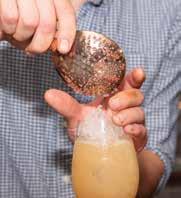

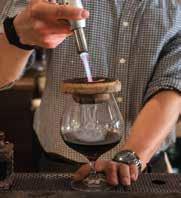
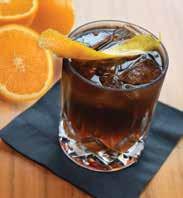
WRITTEN BY L.A. BERRY | PHOTOS BY SUPER SOURCE
Secretariat
A toast, attributed to that prolific author, Anonymous, wishes four blessings: “Older wine. Younger lovers. Faster horses. More money.” Love and money we’ll leave to you but as for cocktails and horsetails, we’ll gamble these libations become odds-on favorites. Especially the Belmont Jewel, Saratoga’s official cocktail of the 157th Belmont Stakes, and as intertwined with horses and history as its Gilded Age namesake, August Belmont, Sr.
The Museum of the City of New York (MCNY) Blog: New York Stories recounts, “The exclusive Assembly Balls initiated in 1882 represent the best and most brilliant of New York Society, organized by a committee [that] included Mrs. John Jacob Astor, Mrs. August Belmont, Mrs. Paran Stevens, and Mrs. Hamilton Fish, and held at Delmonico’s and the Waldorf. As exclusive as the Patriarch Balls they replaced, Assemblies were considered more fashionable.” For such a chaud-froid (“hotcold”) menu, Mrs. Belmont would have chosen brut champagne, claret and Johannis, a German blackcurrant liqueur.
None of her selections inspired an official drink of the Belmont Stakes. That opportunity remained open until 1975, when a more a mundane assemblage of rum, apple liquor and fruit juice was dubbed The Big Apple. Only a handful of racing seasons took a bite before it was replaced with The White Carnation, after the floral blanket draped over the stakes winner, and made with vodka, peach schnapps, orange juice, soda water and cream.
When racetrack patrons sought a less cloying concoction, the Rainbow Room’s head bartender, Dale DeGroff, responded in 1997 with the Belmont Breeze. Feeling that a track drink should be whiskey-based, he made “an old-fashioned whiskey punch which has mint as a garnish.” It included bourbon or rye whiskey, cream sherry, orange juice, pimento bitters, fresh mint and orange zest. In 2015, the Belmont Jewel joined the Triple Crown’s bourbon-based official cocktails -- the mint julep of the Kentucky Derby and blackeyed Susan cocktail of the Preakness Stakes – and this summer, the Jim Dandy Bar at Saratoga Race Course will serve the Belmont Jewel.
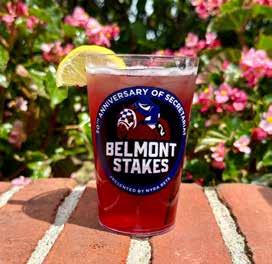
What’s in it? Glad you asked...
The Belmont Jewel
• 1.5 oz. Redemption® Bourbon Whiskey
• 2 oz. Lemonade
• 1 oz. Pomegranate Juice
• Lemon Twist for Garnish
Combine all ingredients in a cocktail shaker. Shake vigorously with ice. Garnish with a lemon twist.

He didn't win the Belmont, but he did capture the hearts of millions.
Racehorse Smarty Jones (PA), a finalist for the first time, is the lone selection in the contemporary category.
The 2025 Hall of Fame class will be enshrined on Friday, Aug. 1, at the Fasig-Tipton sales pavilion in Saratoga Springs at 10:30 a.m. The ceremony will be broadcast live on the Museum website at racingmuseum.org. The event is open to the public and free to attend. Tom Durkin will serve as the master of ceremonies.




Many of the greatest Thoroughbreds since the creation of the breed have been females. Some famous – and others, great – but not given the props they deserved.
The challenge of chronicling the greatest f!llies and mares of all time in one magazine would be an ambitious undertaking, indeed. Still, Equicurean will give it the old college try.
We welcome you to F!LLY-LICIOUS, our homage to these horses, without whose talents our sport wouldn’t have thrived into the 21st Century.
WRITTEN BY L.A. BERRY

What more might be said of the distaff side of the track that author Walter Farley did not say best in The Black Stallion’s Filly? “She accepted their offerings, their embraces, in a very queenly way. Her manner indicated that she was getting only what was long due her and that she had known all along no colt would beat her. “She was that kind of girl.”
Learn more about racing’s distaff side at the National Museum of Racing (NMR) and Hall of Fame, racingmuseum.org, and Canadian Museum of Racing and Hall of Fame, canadianhorseracinghalloffame.com.
In Lexington, Kentucky’s Thoroughbred Park stands an historical marker whose inscription, attributed to U.S. President Andrew Jackson (1767-1845), says all anyone needs to know about how deeply a shrewd horseman can covet a good mare:
Late in life, when asked if he had ever failed in any cause he embraced, the former President replied, “Nothing that I can remember, except Haynie’s Maria. I could not beat her.”
The abiding regret in the life of the seventh President of the United States had nothing to do with politics or patriotism. It was how, despite nine attempts (some might call grudge matches), not a single horse in the Jackson stable could cross a finish line ahead of Captain Jesse Haynie’s Tennessee mare by the aptly named grey grandson of the Godolphin Arabian, Clockfast.
Maria, wrote Barbara Sturn Kupfer in her 1970 A Presidential Patron of the Sport of Kings, entered American racing in 1811, breaking her three year-old maiden trouncing Jackson’s favorite colt, Decatur, by his prized Truxton.
As Jackson stood poised for President Madison to declare war on the British, he sought to avenge his racetrack defeats by declaring war on Haynie’s mare.
“Now, Simon,” Jackson, then-Major General of the Tennessee Militia, is said to have taunted Maria’s jockey, formerly known – yes – as Prince, “When my horse and rider pass you, don’t spit your tobacco juice in their eyes.”
To which Simon – despite enslavement –replied with a tongue as sharp as a new quirt, “Why General, I rode a great deal against your horses but none of them ever got close enough to catch my spit.”
Meet some other North American mares and fillies that rarely, if ever, caught spit.

Judy The Beauty – “She was hardly a beauty. Nothing really wrong with her, but she was on the small side and a bit chunky. Quite ordinary,” was a horseman described the filly at the 2010 Keeneland sale. By age three, she had earned $1.8 million, won the Eclipse Award as champion female sprinter and won the Breeders’ Cup Filly and Mare Spring (G1) at Santa Anita, establishing herself as one of the top female sprinters in North America. “In hindsight,” confessed that horseman, “a huge mistake.”
Lexie Lou - This Sadler’s Wells granddaughter won the 2014 Queen’s Plate, two legs of the Canadian Triple Tiara, and ran second to California Chrome in the Hollywood Derby. Not bad for a $5,500 yearling.
Starship Jubilee – She went from a $6,500 yearling prospect as a useful runner into becoing “the people’s horse,” a $2 millionearning multiple turf champion, and Canadian Horse of the Year.
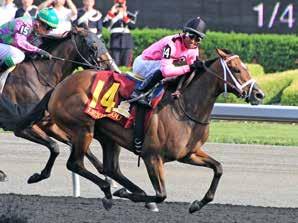
All Along - First filly to win the Eclipse Award for Horse of the Year, also Outstanding Female Turf Horse, inducted to NMR and Canadian Horse Racing Halls of Fame.

Beholder - "You think about other sports and people in the Hall of Fame, and often they have careers where they were good over a long period of time or brilliant over a shorter period of time," said Ned Toffey, manager at Spendthrift Farm. "[Beholder] did both. She was brilliant over a long period of time."
Beldame - This home-bred mare of August Belmont, Jr. (after whose family the Belmont Stakes is named) ranks #98 on The Blood-Horse Magazine List of Top 100 U.S. Racehorses of the 20th Century.
Chris Evert - 1970s sports marketing was at its best. A meeting between two-time (1974 French Open, Wimbledon) Grand Slam tennis titlist, Chris Evert, and 1974 Filly Triple Crown and Eclipse Award winner, Chris Evert, owned by Donald and Shirley Sucher (breeders of 1988 Kentucky Derby champion filly, Winning Colors).
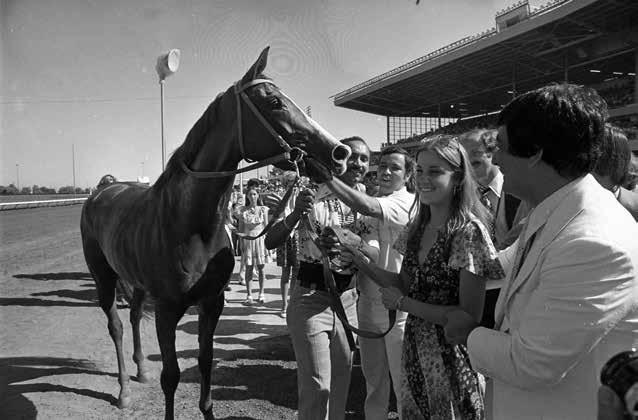


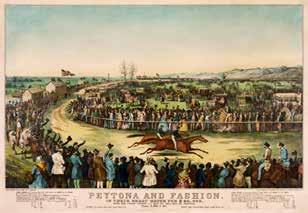

Fashion - A pre-Civil War four-mile record-holder (7:32 ½) who ran in 68 heats and won 55, for earnings of $41,500. Ladies’ gloves and men’s cigars were made in Fashion’s name, as were hotels and steamboats, and she was inducted into the NMR Hall of Fame in 1980.
Goldikova - On November 6, 2010 she made racing history as the first horse to win a Breeders’ Cup race three times, defeating turf champion Gio Ponti in the Breeders’ Cup Mile, and winning two Cartier Racing Awards, Horse of the Year and Champion Older Horse, and becoming the only horse to win Champion Older Horse twice.

Imp - A sprinter and stayer who defeated the best males of her day, Imp’s coal black coat and dainty white star earned her the nickname, Coal Black Lady, after a popular ragtime tune, as she danced to records at a mile and more, and became the first mare (1899) to win the $10,000 New York Suburban Handicap.
Maskette - She never lost a race against another filly. In 1908, as a New Yorkbred two year-old, she was the top filly in the country, having won five out of her six starts and setting a track record of 1:05 4/5 at Saratoga in its 5 ½ furlong Spinaway Stakes.
Rachel Alexandra - Winning the 2009 Preakness Stakes made her first filly in 85 years (since Nellie Morse, 1924) to win the second leg of the Triple Crown. “That’s one thing I look for in broodmares,” breeder, Dolphus Morrison, once said. “Horses that can finish two turns effectively. I prefer a good airway. That’s what makes a good racehorse.”
Regret - No regrets for Brookdale Farm when its two year-old filly became the first horse to win all three Saratoga stakes for two year-olds (Saratoga Special, Sanford, Hopeful). In 1915, Regret became the first filly and first undefeated horse to win the Kentucky Derby.
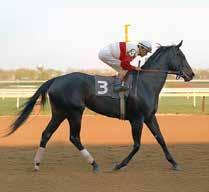

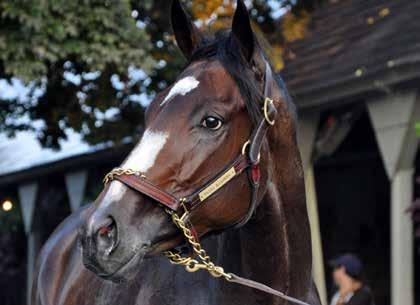

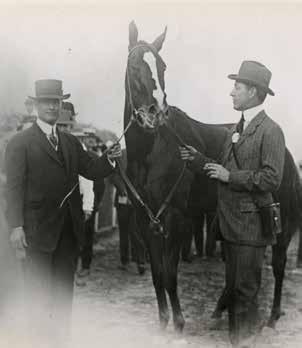
Ruffian - She led at every point of call in every race she ran and set records in all eight stakes races she won. Sadly, she broke down in a July 1975 match race against Kentucky Derby winner Foolish Pleasure and despite surgery, reacted poorly coming out of anesthesia and had to be euthanized. The Blood-Horse ranks her the top filly or mare of the 20th century and her story was told in the 2007 film, Ruffian, and numerous books.
Songbird - “It scares me to think how good she is. I try not to think of it,” said jockey Mike Smith of this half-sister (Medaglia d’Oro) to Rachel Alexandra. The two-time Eclipse Award winner is named for the six-time Platinum selling album of pop-jazz vocalist, Eva Marie Cassidy.
Tepin - Named 2015, 2016 American Champion Female Turf Horse, this true North American star is inducted in both the Canadian Racing Hall of Fame (2020) and NMR Hall of Fame (2022). Tepin is not named for the intensely hot (100k Scoville Heat Units) chiltepin pepper, but for the street on which her owner, Robert Masterson, lives.
Zenyatta - Purchased as a yearling by music record producer Jerry Moss and his wife Ann, she was named for The Police album, Zenyatta Mondatta. Winning 19 of her 20 starts, including the Breeders’ Cup Distaff, she became the first mare (2009) to win the Breeders’ Cup Classic. She was named 2010 Horse of the Year, Champion Older Female (2008, 2009, 2010) and NMR Hall of Fame inductee in 2016.
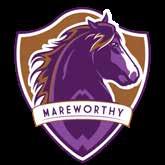
–
She raced her first 87 races on the mainland and last 51 in Puerto Rico, retiring from racing through Caribbean Thoroughbred Aftercare in 2018 at age 14, when she partnered with Kyle Rothfus, aka the ‘OTTB Mare Guy,’ in the 2019 RRP Thoroughbred Makeover. She inspired the word, “mareworthy,’ which became the 501c3 Mareworthy Charities, founded by Kyle as a Kentucky-based program helping mare owners with rehoming and estate planning, and co-host of the 2024 Thoroughbred Broodmare Transition Symposium.


Pan Zareta – “She was fast. She was beautiful. She was smart. Serene as a queen in the paddock, she had her mind on business when she got to the post,” said Fred Newman, whose ‘Queen of the Turf’ and 1914 Champion Older Female won 76 races, more than any filly or mare in history. A true North American racehorse, she ran in eight states plus Canada and Mexico, for earnings of nearly $40,000.
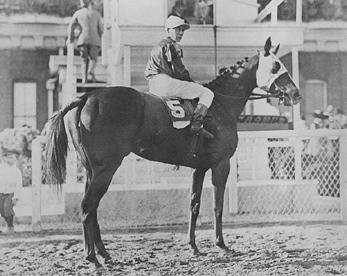
WRITTEN BY WILLIAM G. GOTIMER JR.

'look for the woman'
Credit:
Most racing fans in Saratoga are familiar with the great fillies and mares who have excelled over the years. Ruffian, Zenyatta, Rachel Alexandra, Personal Ensign, Shuvee, Winning Colors, Lady’s Secret and Go For Wand all come to mind when discussing the greats in North American racing.
However, horse racing is an international sport, and many Saratoga race fans are not familiar with great race fillies and mares who have made their mark outside North America. Here we’ll discuss some of the female Thoroughbreds (in no particular order) who have excelled around the world.
Awareness of the international stars of racing has increased with more widespread visibility of televised racing in recent years, but it was the appearance of some great foreign international fillies and mares in the United States in the 1970s that illustrated just how talented the foreign runners were. When the talented Dahlia, Waya and the ill-fated Flying Water came to the United States, American observers were left with mouths agape.
Every region on Earth has racing, and great female horses: we’ll start Down Under...

Black Caviar was undefeated in all 25 starts (14 of which were Group 1’s) from 2008 until 2013. So dominant in the Southern Hemisphere, she ventured to Royal Ascot in to establish her international bona fides and defeated a world-class field in the 2012 Diamond Jubilee Stakes, despite being injured during the running.
Winx was a remarkably durable mare, winning 43 races over seven seasons from 2013-2019. She won an unfathomable 33 consecutive races to finish out her career, including 25 wins at Group 1 level. A versatile runner, she won at both sprint and route distances. Winx won Australia’s Cox Plate four times, a feat unlikely ever to be matched.
Makybe Diva, sometimes overshadowed by the accomplishments of the aforementioned Black Caviar and Winx, is the only horse to win three Melbourne Cups (2003-2005), and the only mare to win it more than once. She achieved the feat in 2003, 2004, and 2005. She also won the 2005 Cox Plate.


When it comes to all-time great Japanese race mares, two stand out: Gentildonna and Almond Eye.
Gentildonna won the Japanese Horse of the Year award twice, and won the Japanese Fillies’ Triple Crown in 2012 as a 3-year-old. However, she proved her greatness that same year by winning the Japan Cup in 2012 and 2013. Her status was further enhanced by her international success in winning the Dubai Sheema Classic in 2014.
Almond Eye is viewed by some as the best filly Japan ever has produced. Horse of the Year in 2018, she also won Triple Crown and the Japan Cup, where she obliterated the race record time before coming back in March at Meydan for an emphatic display in the Dubai Turf. Her other international victories were in Hong Kong.

South America has produced numerous world-class mares, but two who enjoyed success in the United States bear special mention.
Bayakoa won 13 Grade I stakes races, including two consecutive Breeders' Cup Distaffs. The high-strung runner was North American Champion Older Female Horse in both 1989 and 1990. Paseana followed closely in Bayakoa’s footsteps, coming to the United States after four Grade 1 wins in Argentina. She also amassed two Eclipse Awards as Champion Older Female in in 1992 and 1993.
Both Bayakoa and Paseana are in the Racing Hall of Fame.



There have been so many great fillies and mares in Europe: it would take a book to laud them all. A partial list from A-Z includes; All Along; Allez France; Dahlia, Enable; Goldikova; Miesque; Ouija Board; Treve and Zarkava.
Miesque won 10 Grade/Group 1 races across the United States, France and England. She won at graded stakes at ages two, three and four. She became the first horse ever to win consecutive Breeders’ Cup races (the Breeders’ Cup Mile) I 1988.
As a broodmare she produced 14 foals, six of them winners. That list included Kingmambo, an influential. Miesque has made global impact in global as among her maternal descendants are Japanese-bred Group 1-winning stars Loves Only You, Real Steel and Karakontie.
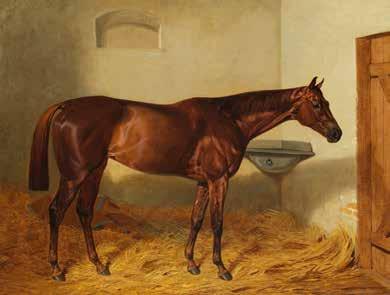
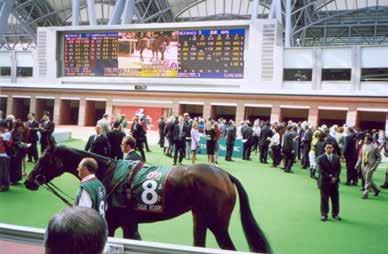

Ouija Board had 22 starts with 10 wins and 9 seconds. Ouija Board was well travelling racing England, Ireland, France, United States, Japan, Dubai and Hong Kong. Her accolades included European Champion Three Year old filly (2004), Eclipse Award winner for outstanding Female Turf Horse (2004 and 2006), European Horse of the Year (2004 and 2006) and European Champion Older Horse (2006).
Treve French 2013 European Horse of the Year winning all four of her starts as a three year old including the Prix de Diane, Prix Vermeille and Prix de l'Arc de Triomphe. Treve would win the Arc again in 2014. She finished her career with 9 wins from 13 starts.
In addition to the above, three race mares from long ago deserve special mention...


Kincsem - Going back to 1876, we recall this great race mare from Hungary, who was undefeated in 54 starts – yes, 54! Kincsem won races in Hungary, Germany, England and France during her career, and once defeated a rival -- carrying 53 fewer pounds in weight. The adage – “don’t judge a book by its cover” applied to Kincsem, once described as “plain-looking and lazy.” She was also reported to be temperamental, and would refuse to eat or drink when the food and water were not to her very particular liking.
Many legends about her ability and personality became lore, including how she saved herself “Home Alone” -style from being stolen by thieves from her stall! One confirmed legend was her refusal to travel (which she did often), without being accompanied by her chosen equine and feline travelling companions.
So great was her influence, that the racetrack in Budapest is named in her honor – Kincsem Park - and a movie version of her life was produced in 2017 – Kincsem – Bet on Revenge.
Sceptre - Owned and partially trained by a perpetually cash-strapped Robert Siever, (who sought to live off her earnings and betting proceeds), this legendary mare had an outstanding year in 1902, winning FOUR British Classics (2000 Guineas, 1000 Guineas, Oaks, and St Leger). Inbetween those wins, she finished fourth in the English Derby after a poor start.
Sceptre also defeated colts, winning the St James' Palace Stakes, the Hardwicke Stakes at Royal Ascot, and the Champion Stakes as a four-year-old. After a relatively short career, she retired with 13 wins, living out her days until 1926 in her English home.
La Camargo is considered the most famous French horse of the 20th Century in France. She was named after Marie de Camargo, the famous French ballerina who was one of the first dancer to wear ballet slippers instead of heeled shoes. La Camargo made 34 starts with 24 wins, six seconds and one third. La Camargo was a stakes winner every year from 1900 to 1903. In 1902 and 1903 she won the prestigious Prix du Conseil de Paris, which prior to the creation of the Prix de l'Arc de Triomphe, was the most prestigious race in France.

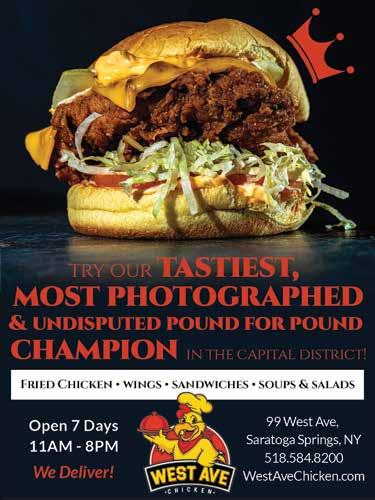
While Native Arabian horses have been raced for over 5,000 years, much of The Middle East has had organized Thoroughbred racing a relatively short time, compared with other regions: racing in the UAE began in October, 1981, at the dusty Camel Track in Dubai. Saudi Arabia’s first races took place in 1920, and the Baghdad (Iraq) Equestrian Club was founded between 1917 and 1920.
From the Camel Track moving forward, the Dubai Racing Club began organizing races first at Nad al Sheba Racecourse in March, 1992, then moved to the modern marvel, Meydan, in 2020.
Polar River won the first four races of her career, including the 2016 UAE Oaks, then faced males in the 2016 UAE Derby, where she finished second. Polar River made eight starts in Dubai, winning half of those races and earning $769,099.
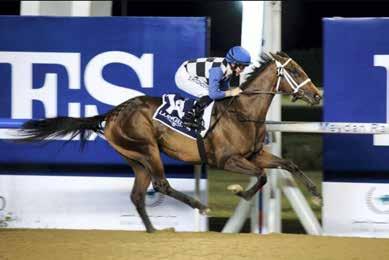

Midnight Bisou - Ironically, the most accomplished mare to run in Saudi Arabia, Midnight Bisou, did so just once but with success. After a stellar racing career in the United States, the daughter of sire Midnight Lute (a sprinter), faced colts in the inaugural Saudi Cup with its record-breaking $20 million purse. Midnight Bisou ran a bang-up race, losing to Maximum Security by a half-length, only to be declared the winner more than four years later, when the winner was disqualified. In one fell swoop, she became the most noted mare in Saudi Arabian racing. It appears clear that the international racing fillies and mares compare nicely to those competing in the United States, and have a major impact when venturing to the United States to compete. Similarly, the great race mares of Australia and Japan have traveled to the UK, to prove their international status and taking on tougher competition. They have been largely successful when doing so. Some have shown brilliance, while others have shown durability and consistency. International fillies and mares remain a formidable force in racing.



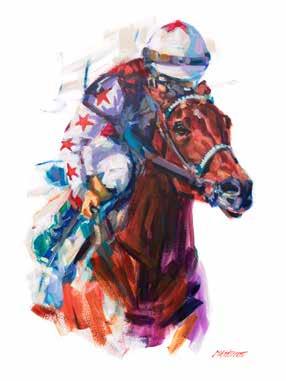
WRITTEN BY MARION E. ALTIERI ARTWORK BY LISA PALOMBO
The 19th Century Art movement known as Impressionism was an act of outward rebellion against historic artistic conventions. Monet, Manet and Renoir are three of the most-recognizable names of that style. (Even to those who are not lovers of Art.)
Men comprised the majority of the Artists who thrived during the era, but several women painted the world through their own Impressionistic eyes: Berthe Morisot, Mary Cassatt, Eva Gonzalès, and Marie Bracquemond are the best-known of the pioneers.
While a few females here in the early 21st Century categorize themselves as Post-Impressionists (rebellion against the original rebellion of Impressionism), precious few – perhaps only one – self-refers as simply, American Impressionist.
In fact, Lisa Palombo may be the only living female American Impressionist.
Read that again: …the only living female American Impressionist.
© LISA PALOMBO
A heavy mantle to bear, which on a more-frail spirit might weigh too heavy to bear – Palombo wears the crown with great humility and grace. A lively spirit, a cutting wit and sagacious intelligence give great insight into the Artist’s methods. Inspired, one moment she may pick up her brush, and attack the canvas with great passion and ferocity…while, in another moment, she approaches the blank space with great reverence, and solemnity.
Each painting tells its own story, giving clues to its roots in Palombo’s spirit.
Obviously, her works are sought-after by savvy art collectors, fans and… horse lovers. Lisa Palombo has a true gift, for capturing the soul of a Thoroughbred, and the swiftness of the breed’s very soul.
Saratoga is blessed to host this singularly-talented maestra again this summer, at Spa Fine Art on Broadway.
The virtuosa has a long relationship with the Gallery, in fact, mounting several times over the years, including 2022: Big Red, White & Blue solo exhibition and in 2023, her wildly-popular Secretariat, a joyous celebration of the Champion’s 50th Triple Crown victory. (Many readers of Equicurean remember that delightful show.)
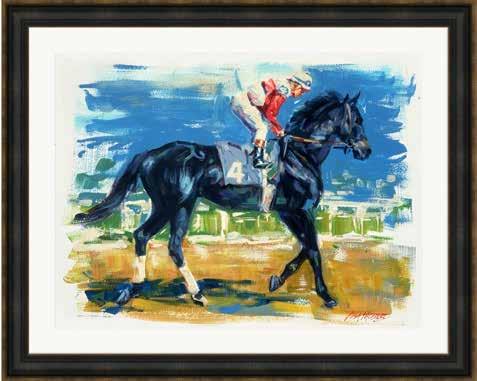

A Preview Reception of her 2025 Saratoga show, Famous Fillies, will be held at Spa Fine Art on June 6th, from 6 – 8 p.m.
The Grand Opening Reception for Famous Fillies will take place on July 31st from 6-8 p.m. The full show will feature paintings, Dream Race (Zenyatta and Rachel Alexandra); Thorpedo Anna; Lady’s Secret; Ruffian and seven renowned Fillies in the starting gate, running right atcha.
Both receptions are open to the public, but your RSVP to the Gallery would be appreciated. Please call Spa Fine Art 518- 587-2411 to assure your place at either or both soirees.
(Special appearances by racing celebs may be announced soon; watch the Gallery’s Website for updates!)
Signed Prints of Horse of the Year, Thorpedo Anna, will be available for purchase at the Receptions, and may be purchased online, as well: lisapalombo. com/product/thorpedo-anna/
When making your plans for Saratoga this Summer, put Lisa Palombo and her singular talent the top of your list.










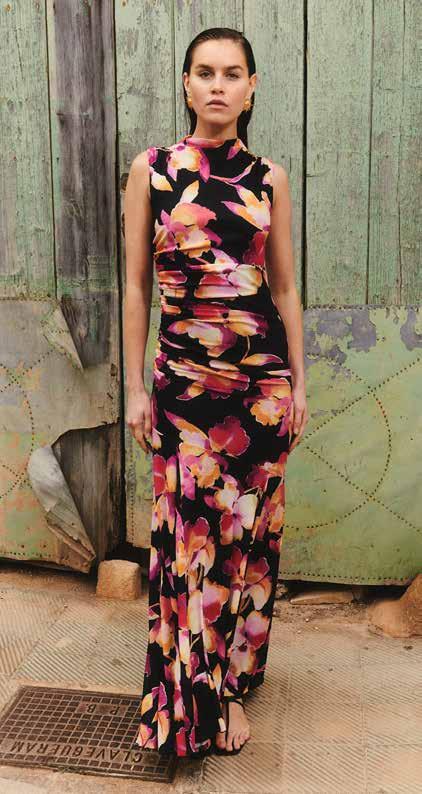




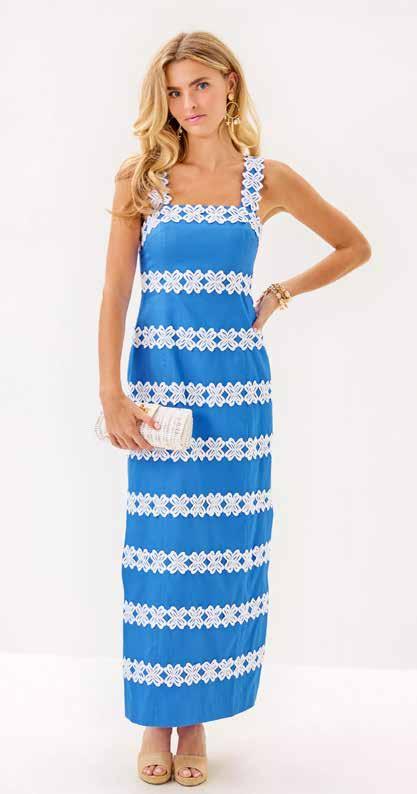

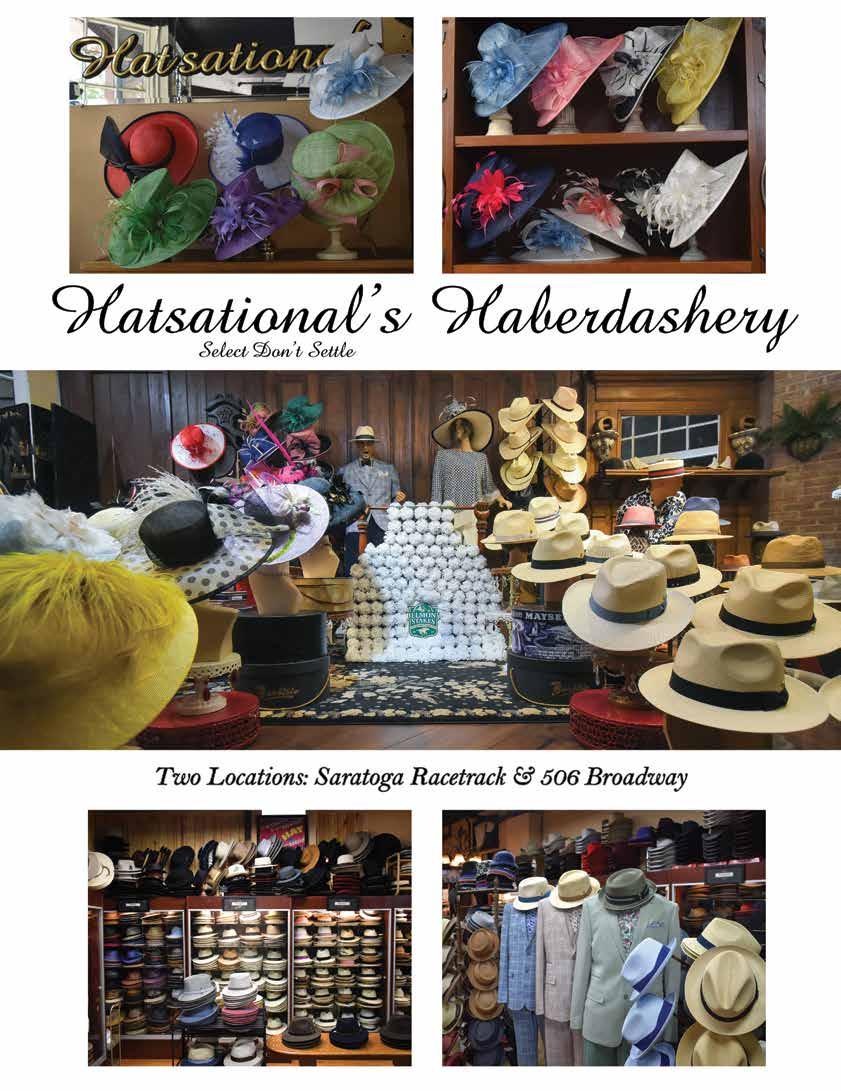

Mary Hirsch, New York’s first-ever female Thoroughbred racehorse trainer.

WRITTEN BY L.A. BERRY
PHOTOS COURTESY OF THE NATIONAL MUSEUM OF RACING AND HALL OF FAME

It wasn’t even the first New York news item in the Saturday, May 9, 1936 Kentucky Derby edition of The Blood-Horse. The editorial desk had opted for a nod to the Excelsior Handicap and Rosedale Stakes concluding Jamaica’s 22-day meet. In fact the noteworthy citation read as soft as good hands on a horse trainer. But when Mary Hirsch’s Winners came up next in the column’s news of note, it included something no such edition had mentioned before: New York’s firstever female Thoroughbred racehorse trainer.
“When Max Hirsch went with Bold Venture to start the Morton L. Schwartz colt in the Kentucky Derby, he turned all his horses in the east over to his daughter, Mary Hirsch, first woman granted a trainer’s license by The Jockey Club.”
It went on to credit Mary Elizabeth Hirsch with saddling winners Joyride and Flying Mare in both six-furlong divisions of the Tester Purse on the April 28 Jamaica card, and with bringing J.W. Marr’s Say Do to third in another race.
It did not mention how she was loaning her father a young apprentice rider under her own contract to ride the Derby-bound Bold Venture. Nor how long a race she had privately run to win the right to be called a racehorse trainer... So we will.
Lineage is everything in fine Thoroughbreds and it was the crossing of skill with opportunity that contributed to the development of New York’s first woman trainer. Mary was the daughter of a horseman known trackside as the “trainer to millionaires,” Max Hirsch. Her father was born in Fredericksburg, Texas in 1880, and as a lithe boy rode at county fairs and in quarter-mile races before heading east with the D.H. Morris stable, becoming a good lightweight metropolitan rider until the years and scales caught up with him and, as BloodHorse Weekly January 4-June 27, 1936 records recount, “Max Hirsch undertook a course in the training of horses.
“How well he succeeded,” it continued, “is racing history. In the thirty-odd years that have elapsed, Max Hirsch has cut his name deep in racing history. One of his sons, Buddy, is a good trainer and his daughter Mary enjoys the distinction of being the first woman granted a trainer’s license in New York State – she too is following in her father’s footsteps.”


Mary Hirsch was the first licensed female to saddle a winner at Saratoga and held the record as the only woman to train a G1 Travers Stakes and Man o’ War Cup winner until 2023, when trainer Jena Antonucci saddled Travers winner Arcangelo for Blue Rose Farm, under jockey Javier Castellano.
As of 2024, Mary Hirsch remains one of only 18 women trainers to start a horse in the Kentucky Derby.

Following in his footsteps while making her own strides, if one goes by the assessment of Turf and Sport Digest roving reporter Jimmy Loftus. In his October 1935 Talk O’ the Turf look at lady trainers who had “crashed the gate” he wrote, “The licensed women trainers in America can be counted on the fingers of one hand. There is Mary Hirsch, the pioneer in this new vocation for career-seeking ladies; Hambla Bauer, the young lady from the swank halls of Radcliffe College, and one or two more lesser known to the racing public.”
Loftus dubbed the diminutive dark-haired 20-something “La Hirsch,” but she earned respect as “a credit to her sex and to the sport she has adopted. Whether directing her stable hands through training routine at early dawn, hobnobbing with society’s ultra-ultra in Saratoga’s clubhouse in the afternoons, or dancing at swank balls in the evenings [she] maintains poise and dignity beyond her years. Among the hard-bitten, masculine horse clans she is accepted as one of their own. They know that she belongs.
“Through breeding and environment and love of the sport, she is a true princess royal of the race paddocks,” he continued, candidly recounting how how hard she fought to race as a trainer under her own colors -- yellow jacket, red sash, red blocks on sleeves, red cap.
“I fancy the pompous, tradition-bound heads of the Jockey Club were somewhat aghast when they first cast their eyes on the application for a trainer’s license filed by one Miss Mary Hirsch. I imagine they hemmed and hawed and puffed out heavy-jowled cheeks.”
Instead, he wrote, what the Jockey Club did was the unimaginable: “They pigeon-holed her application.”

Hirsch was just 20 years old when she applied in 1933 for her New York trainer’s license but she had years of hands-on experience working trackside with her noted father. The Jockey Club, unmoved, tabled her application – a gentleman’s euphemism for denied. And yet she persevered, looking to the Midwest circuits and applying for – and receiving by July 1934 – licenses to train in Illinois and Michigan. By the time the Jockey Club decided to reverse its decision two years later, she was licensed to train Thoroughbreds virtually everywhere in the United States and Europe.
Hirsch had a good eye for horses and for those who could handle them. In 1936 she may not have had a horse in the Kentucky Derby like her father, but she owned the contract to a promising young apprentice named Ira ‘Babe’ Hanford and loaned his riding services to Max, who was saddling Schwartz’s colt, Bold Venture.
“At the time it seemed rather a dubious favor, since Bold Venture never had won a stake, and no apprentice ever had won the Derby, to say nothing of the competition the neophyte pair had to face,” recounted William H.P. Robertson in his 1964 History of Thoroughbred Racing in America. “By the time he entered ‘heartbreak lane,’ the Schwartz colt had more than a length to spare over Indian Broom, as Brevity came charging up, racing wide. The favorite passed Indian Broom and ate into the leader’s margin all through the stretch but the end came too soon. Bold Venture won by a head.”
Hanford became the first apprentice rider to win the Derby but would not ride in the Preakness, where the tightly contested finish between Bold Venture and Granville became a seminal moment in the use of the photo-finish camera to decide outcomes and, in this case, to Bold Venture’s favor. But it was a Pyrrhic victory. A bowed tendon prompted the colt’s retirement and the Belmont Stakes went to the tenacious Granville.


When Mary Hirsch earned her New York trainer’s license it also assured that Saratoga Race Course would never be the same.
A Women in Racing display in the McBean Gallery of the National Museum of Racing and Hall of Fame from 2019 through 2022 included the Grade I Diana Stakes trophy –named for the mythological huntress – bearing Hirsch’s name.
“I have a few horses that can run fast,” she drolly told a New York Times reporter. “If they escape illness and injury, I think they can win in New York.”
Including a son of Brooklyn Handicap winner Sortie, No Sir, who won in Saratoga for Hirsch in 1936 before joining a 20-horse field, and finishing 13th, in the 1937 Run for the Roses.
Nor was Hirsch a stranger to a Saratoga summer’s notorious atmospheric turbulence. Also in 1937, lightning struck horses in Hirsch’s barn, including Anne Corning’s two-year-old, Thanksgiving, who was found knocked out cold on the ground.
Thanksgiving recovered and, as a 4-to-1 underdog the next summer, posted the fastest (2:03 3/5) winning time since Man o’ War in 1920 in the 1938 Travers Stakes, finishing under jockey Eddie Arcaro six lengths ahead of Jolly Tar.
It made Hirsch – with a horse lucky to be alive – the first female trainer to win the Grade I Travers Stakes. But no reports recounted the horse’s remarkable journey and lending insult to injury, some news accounts still erroneously identified her father Max as trainer.
From 1935-1939, New York and Saratoga’s first female trainer saw 84 wins add up to cumulative earnings of better than $104,000 (roughly $1.8 million today). She concluded her training career in 1940 after marrying Maryland racing secretary Charles McLennan but bred horses at their Cowpens Farm in Towson, Maryland until the 1970s.
“These were exceptional earnings in the midst of the Great Depression and in an era well before large purses,” cited emeritus professor and horse racing author, William L. Shankin, in a 2020 Paulick Report commentary arguing how the number of female trainers inducted into Thoroughbred horse racing’s Hall of Fame was still a woefully short list.
Mary Hirsch, Shankin said, boldly challenged the male-only policy and broke the glass ceiling for future generations of women trainers. He would have found no dispute from railbirds like Loftus.
“She was the one,” Loftus wrote, “who smashed down the door of tradition that thoroughbreds shall only be trained by men. She was the first woman to receive a license and she has led the way for her sex, consolidating their position by a sound exposition of the horsemen’s arts and a notable success in saddling winners."
“To her the ladies can lift their glasses, for opening a new vocation filled with interest and excitement, and a full measure of public attention.”
Learn more about Mary Hirsch and horse racing history at the National Museum of Racing and Hall of Fame, www.racingmuseum.org.

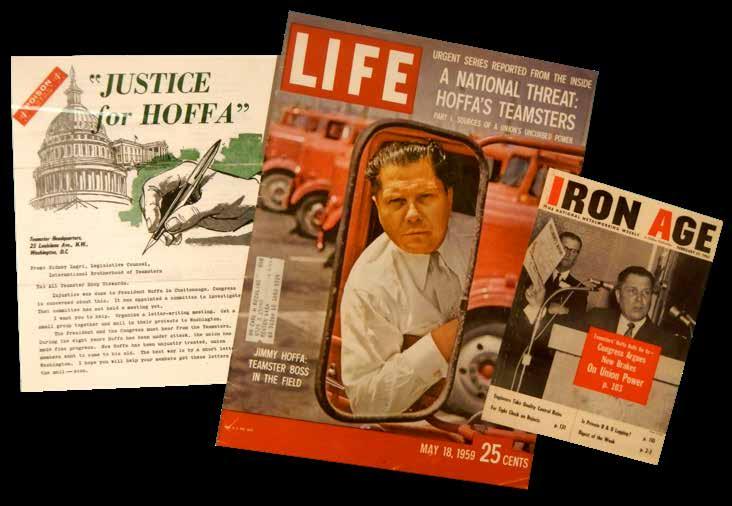
WRITTEN BY MATT BONK, SARATOGA COUNTY HISTORY ROUND TABLE | PHOTO PROVIDED
There were only 14 horses at Saratoga Race Course in late July of 1961. By that time, it was expected that at least 200 would have arrived for the racing season. Strikes led by Jimmy Hoffa and a branch of his Teamster Union, Local 917, halted the transportation of horses from New York City to Saratoga Springs. Teamsters wanted to force themselves into a position of being representatives in labor negotiations for approximately 1200 backstretch workers at Belmont and Aqueduct racecourses. Picket lines consisting of these workers formed outside the racetracks and Teamster truck drivers were ordered not to cross. No horses were to be delivered until better pay and improved working conditions were granted to the workers.
Horse owners, who normally decided wages for the workers, refused to negotiate with the Teamsters and were stuck in a difficult position. Who was going to bring their horses to Saratoga Springs? They could have found different trucks and drivers, but increased violence in the picket lines kept them from doing so. A stabbing occurred on July 22, which involved both union and non-union workers. That same day, a van operated by non-union drivers was pelted with rocks as it attempted to deliver horses to Aqueduct. The risk involved with crossing the picket lines was too great and deterred horse owners from employing any outside help for the job.
During the days that followed, the strikes and picketing continued while negotiations between Teamsters and the State Labor Board remained at a standstill. Consequently, horses were not being delivered at a rate that would ensure races could proceed as scheduled. With about a week until opening day, the entire racing season was put into question. Tension began mounting as this news spread and the Mayor of Saratoga Springs, James Benton, reached out to anyone who could help aid the situation. Among others, he was communicating with the State Labor Board, the Chamber of Commerce, the State Mediation Service, Lieutenant Governor Malcolm Wilson, and Governor Rockefeller. Everyone he spoke to assured him that racing would proceed as scheduled. These assurances were difficult to get behind though since negotiations between Teamsters and Labor Board representatives were making no progress.
Perhaps trying to circumvent these complications, Benton went straight to the top and spoke with Jimmy Hoffa on July 25. Aside from his role as mayor, Benton was the owner of the Grand Union Motel on South Broadway and was involved in many city projects. His ultimate concern was for the city and understood that its livelihood depended on business generated during the 24-day racing season. Hoffa was also aware of this and used it to his advantage. He made it clear he would only transport horses once labor demands were met. Benton suggested that Hoffa allow his drivers to move the horses and resume strikes in Saratoga, but Hoffa remained obstinate and rejected any pleas or compromises presented to him.
In the meantime, plans for using trains to move the horses had been quietly formulated. Trains were an outdated method of transportation at that point, but the equipment needed for the task was still available. The New York Racing Association employed “special cars” for the use of transporting horses, and on July 26, D&H Railroad was seen putting up a “horse siding” at their West Circular Street depot. The trains were to be routed through Connecticut and Massachusetts before coming to New York. Changes made to the railways in recent years prevented the special train cars from clearing certain bridges, so this indirect route had to be taken.
On July 27, the first bulk of horses arrived successfully. As early as 5 a.m., 60 people gathered outside the D&H depot to watch the horses unload and parade their way to the stables. In a way, this was reviving an old tradition, albeit against the will of the city. Back when horses were normally brought by rail, people would gather to watch as they were unloaded and then guided across Broadway and down Union Avenue to the racecourse. The event was symbolic of mid-summer and assured citizens that the city would soon be booming. A total of 3 trains and 8 vans arrived between 3 a.m. until around noon that day, bringing a total of over 100 horses. The vans were able to make the trip undisturbed thanks to protection given along the way by state police, city police, local sheriffs, and Pinkerton Security.
The operation continued into July 28 and approximately 400 more horses arrived. This shift in momentum, from no horses to suddenly over 500 horses delivered in 2 days, coincided with a break in the Teamsters’ position. A spokesman for the Eberts Van Co., one of the major horse transporters that was previously honoring the picket lines, said that 6 of his 7 drivers went back to work. It’s likely that with little headway being made with negotiations, drivers chose to resume work and not completely lose out on money. The next few days were relatively peaceful, and Saratoga Springs continued to receive horses uninterrupted.
On July 31, opening day at Saratoga Racecourse, the front page of The Saratogian announced, “Fans, Horses, Stream to Racetrack.” With nearly 1300 horses on the grounds and over 12,000 people attending, races proceeded as usual that day. Threats of pickets and strikes coming to Saratoga Springs were revealed to be harmless. Only a handful of picketers were seen outside the gates of the track that morning. Even though labor disputes would continue through the following months, they would never reach the level they did during the week leading up to opening day. Special thanks to Chris and Larry Benton for telling me stories about their father, Mayor James Benton, and offering their insight regarding the lead up to the 1961 racing season.

INTRODUCTION WRITTEN BY CAROL GODETTE
Driving by 148 Union Avenue, one hardly notices the stately three-story white clapboard house with green trim. The building is tucked into a corner surrounded by a black iron fence and shrouded with shrubbery, marked by a small sign on the front screen-"SARATOGA READING ROOM.” Originally intended as a private social club for men only, The Reading Room was founded for Thoroughbred horse owners, trainers and breeders to read the daily racing papers before crossing the NYRA grounds for the afternoon racing. It later became an exclusive dining club serving breakfast, lunch and after-race cocktails for its members. Few local residents ever entered the building, unless they were there to work. From 1972-1989 The Reading Room’s kitchen and dining rooms were staffed by a group of young black athletes living on the west side of Broadway, which they referred to as the “Best Side” of Saratoga.
Ernest “Sonny” Gooden, a 6”2” basketball star at Saratoga High School began as a dishwasher in the Reading Room due to his father’s job at the track. As positions in the Reading Room opened up, Sonny would recommend neighborhood relatives and friends. Two dish-washing positions became available and Sonny recommended his friend Eddie Pinn and his cousin Stewart White.
“We had fun and made lots of money,” reflects Stewart. Both teenagers knew if they worked hard, they could make serious money by being promoted to waiters. Within a few years, both were wearing the coveted white jackets of a Reading Room waiter. That’s when they got to meet people that may never have otherwise crossed their paths.
For both Sonny and Stewart, the job was really about the relationships they built with the regulars. “We were so comfortable around them and they were equally comfortable around us,” said Stewart.
In today’s world where stories of racism and prejudice are all too frequent, Sonny and Stewart didn’t experience any of this at the Reading Room. “Our boss wouldn’t stand for any disrespect. Once someone who came for sales week was disrespectful and the maitre d’ sent them packing. He had to apologize to us, or his membership would be revoked,” they both stated.
Pittsburgh Pirate owner John Galbreath and horse trader Stanley Petter were just a few of the patrons who were interested in Stewart's and Sonny’s personal lives. “We were all playing ball at the time, especially Sonny ‘cause he was the MAN,” jokes Stewart-referring to Sonny’s success on Saratoga High’s basketball court. (When Sonny was inducted into the Capital District Sports Hall of Fame, he was described as the best basketball player Saratoga High ever had.)
“The people at the Reading Room got us ready for college. They went out and bought some of our stuff like trunks and supplies,” they fondly recall.
Stewart, Sonny and their friends worked hard and were good at what they did, always going the extra mile for their favorite patrons. Stewart describes the job as a “match made in heaven.” Eventually Stewart’s brother James was also hired. When James passed away two years ago, it inspired Stewart to document their experiences in the story “Saratoga’s Best Kept Secret.”
Equicurean is honored to bring you the first installment…



A Story of Thoroughbreds, Wealth, Relationships and the Black Men and Women Workers at The Saratoga Reading Room
My name is Stewart White. This story is being told through the eyes of a then 18-yearold young black man, who grew up being part of an era of hard-working black men and women, in the private world of the rich and famous. That era is a part of black history that has been around for many years. I am sharing my part of that history.
I worked at the Saratoga Reading Room for 17 racing seasons - from 1972-1989. I serviced and sometimes “rubbed elbows” with many of the who’s who list of members and their guests that walked through the Reading Room gates. Members such as Sonny Werblin (former owner of the NY Jets and President of the NY Knicks), Mr. Henryk de Kwiakowski (aeronautical engineer and owner of Calumet Farm, a prestigious Thoroughbred racing farm that produced some of the greatest Thoroughbred horses of all time), George Steinbrenner (owner of the NY Yankees), Wellington Mara (owner of the NY Giants), Alfred Z. Solomon (a famous hat maker), Charles Eble (former President and CEO of Con Ed), and C.V. Whitney (filmmaker, businessman and owner of a leading stable of Thoroughbreds).

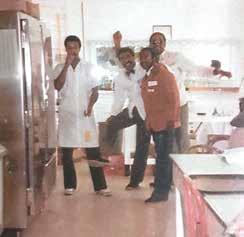

The Reading Room included six rooms upstairs for members to stay overnight after a long day at the track. It was a men’s club, so during the morning hours, women were not allowed above the 1st floor. It wasn’t until the 1980s that women were allowed honorary memberships, but only after the death of their husbands who had been members.
When my cousin Sonny Gooden, who had started as a dishwasher at the age of 14, brought me on in 1972, there were zero black members. If you saw a black man or woman in the Reading Room - believe me, they were working! The only exception during those early years was a fair skinned, very handsome gentleman by the name of Cab Calloway. Calloway, a legendary jazz musician, was a guest of a member. In those early years during the 70s, the entire working staff was black. We were a close-knit group made up of black folk who would migrate from their Southern roots or jobs on the railroad to find work at the racetrack. There was lots of money to be made in Saratoga during the track season... Lots of money to be made at the Reading Room.
During those times, every behind-the-scenes employee was a black face and there were very few exceptions. The cooks, waitresses, bartenders, bathroom attendants, busboys, greeters, maître d’s, valets, and even whomever was running bets to the track – they were done by someone with a dark face. To tell you the truth, the members seemed to like it that way.
A typical day at the club started at 5 a.m. Our boss during the early 70s was Otis Buggs, a short older man with a noticeable limp. He was an old-school Southern man who you could tell took pride in his role as leader of this group of hard workers.
At this time, there were three of us youngsters working, all in our late teens. Sonny, myself, and our longtime childhood friend Ed Pinn. We used to marvel at the way the older waiters used to work. They were extremely hard workers who were very skilled in their craft. For being older, they could sure move! There were three layers to a day at the Reading Room: breakfast, lunch, and then members would return for cocktails after the races. Breakfast was very laid back. The menu was simple, consisting of hot and cold cereals, Saratoga’s famous hand melon, many typical breakfast items including eggs benedict, and the members' favorite - our tiny little pancakes or crepes.

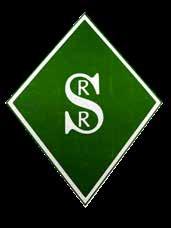
As young boys in the kitchen, we were curious about what went on outside the kitchen, so a lot of time we would wander about. We would go out on the porch or lawn and we got to know a few of the members who were there day after day. Frank Wright, a top trainer of Thoroughbreds and a former CBS racing analyst, sat at the same table every morning. He would talk with us along with Stanley Petter, a horse breeder out of Lexington, KY. Mr. Cot Campbell, who founded Dogwood Stable, the 1st known racing partnership in 1969, was also a favorite of mine. They were very friendly and we used to look forward to talking with them. They seemed to enjoy our youthful enthusiasm. After breakfast there was the typical prep for lunch. The lunch menu consisted of soups and hot or cold sandwiches. Members would come in with their families, eat a good meal, and leave for the start of the races. The staff in the kitchen, from the preparers of the food, servers, all the way down to us dishwashers, worked well together. Lunch, though very fast paced, had a flow that ended up being very precise. We were like a well-oiled machine.
One thing I used to notice was the money that the servers were pocketing, even though we knew that members signed for their checks. There were no cash transactions that took place at the Reading Room. Most of the tips for the servers consisted of 20% of the total check. A lot of members would also give a cash tip, on top of the tip included in the check. Members seemed not to be cheap. If you gave them good service, they were very good tippers. We took notice.
After having some down time while the races were going on and the club was basically empty, it was time to prepare for the members and their guests to return to drink, smoke cigars, and talk about their day at the racetrack.
A fringe benefit of working at the Reading Room was the crazy tips on horses we would get from the members. Everyone used to get their bets together for the runner who stopped by daily to run bets for the staff. Every now and then I would be asked to take a bet over for a member. I remember running a bet for Harry M. Stevens III, who at the time had food catering concessions around the country in places like Madison Square Garden, Shea Stadium and the Meadowlands Sports Complex. I mean, I was actually running! Mr. Stevens handed me $200 and told me he needed me to place his bet before the window closed. I was young and athletic. I made it in time.

WRITTEN BY BILL ORZELL
An older friend who I was able to assist in a matter which was simple for me, but not for her, rewarded me with a gift of appreciation. Being aware of my interest in thoroughbred racing, she presented me with a piece of horse racing’s past, which had occupied the lower recesses of a drawer in her home for many years. It is a paddock badge, which piqued my curiosity.
The artifact reminded me of something issued at a clambake, a serialized paper fob, with a small hank of gold string, allowing for easy display utilizing a buttonhole. This particular paddock badge is green and gold, and was issued for the Spring season of 1949 at Belmont Park for the admission of an owner/trainer, listed on the badge as “A. L. Aste.” This gentleman had been involved with thoroughbred racing for decades at that point in time. He competed under the name Ascot Stables, racing in brown silks with a red sash with red and white stripes on the sleeves and red cap.
The original owner of the paddock badge and his bride visited Saratoga Springs on their honeymoon, and perhaps it is best to allow the local organ to present the introduction. The July 10, 1889 Saratogian wrote under the headline “RISE and SHINE,”

“Among the arrivals here on Monday were Antonio L. Aste and bride of New York. This young couple are modest people, and are famous despite themselves rather than from desire. The happy bridegroom has the distinction of being a "master-shiner" in the boot-blacking fraternity in the metropolis. His bride was a teacher in an Italian public school in Leonard Street. Mr. Aste is about 24 years old.”
The daily further mentions his bootblacking concession at the Produce Exchange and his opening stands in other downtown buildings in Manhattan, where he employed a large force of “shiners” and mixed with the giants of commerce at that time. The article concludes with “The business and social rise of "Tony" Aste is only one more instance of the possibilities that are within reach of pluck and industry and frugality under the flag, of the free. Much joy and long lives to Tony and Mrs. Aste.”

Tony Aste was credited with installing the first high-chairs for shoe-shine use at the Produce Exchange, a new standard for that industry. He expanded his operations and opened more stands across New York. In 1890 he worked with a chemist to develop a polish for his shoe-shine stands, which evolved into the Griffin Shoe Polish Company with manufacturing facilities near his residence in Brooklyn. His new found fortune allowed him to pursue his interest in thoroughbred horses and participate in the sport of kings for the rest of his life.
A. L. Aste would have been a participant at many tracks which no longer exist and the contemporary of other notables in the sport, such as August Belmont and William C. Whitney. In 1901 Mr. Aste, refining his understanding of the way the sport was played, pinhooked the colt Nasturtium, for which he had invested $4,300, and sold him to Mr. Whitney for $50,000.
These same two contemporaries of Antony Aste, Mr. Whitney and Mr. Belmont, were principals in two separate, yet very much related, concurrent construction projects in the rebuilding of Saratoga Race Course, completed 1902, and the new construction of Belmont Park on Long Island, which opened in 1905. Both projects shared the architect Charles Leavitt. An advantage the downstate track had over the Spa was that the property purchased for construction, the former Oatlands Estate of William De Forest Manice, included an anglophile style manor house, thought at that time to be more than a century and a half old. The Manice Mansion, a palatial gray stone Tudor-Gothic edifice with nearly one hundred leaded glass windows and accompanying shutters, castellated turrets and quoin posts tapered to conical finials and a lofty square tower, fronted on Hempstead Turnpike. Mr. Manice was in the unique position as a global shipping magnate to collect plant specimens from around the world as a hobby, and placed them in his own display. The structure was surrounded by magnificent gardens with a wide variety of flowering and fragrant plants, groves of trees, and grounds that included pools and fountains. Architect Leavitt included the structure in his design plans as the Turf and Field Clubhouse, serving that purpose until 1956. Mr. Aste would have been a participant during these constructs, and enjoyed the pleasures of the Turf and Field Club.


Many print articles of the early twentieth century describe Mr. Aste by using the word “calabrece,” a reference to descendance from the Calabria region to describe an Italian immigrant, finding it comical for a bootblack to mix with millionaires. The New York World wrote June 17, 1903, “Perhaps you regard a nickel as a mighty small fortune, but if you will read these few lines you may have more respect for the 5-penny bits. A man who twenty years ago started on a capital of one lone nickel has just outbid three millionaires for the privilege of owning a race horse he coveted. He bought the horse, a colt by imported Watercress—Inquisitive for $7,100, or 142,000 nickels paid to him by more than 100,000 persons. The man is Anthony L. Aste, the ‘King of the Bootblacks.”
Thoroughbred yearling purchases are always tremendous risks, and this colt would fail to ever appear on a race course. Mr. Aste would soon begin expanding his shoe-shine booths to Gotham’s ferryboats.
Escalating his thoroughbred competitiveness, Anthony Aste became a breeder, using the Barbee Farm in Kentucky. In 1913 legendary Hall Of Fame owner/breeder John E. Madden asked Mr. Aste for a price on the colt Ten Point, the leading contender for that year’s Kentucky Derby. Mr. Aste refused a terrific offer, and Ten Point finished runner-up by a half-length in Tony Aste’s colors in that years run for the roses to Donerail, the longest odds winner in Derby history.

A highlight for Tony Aste came in the summer of 1918 when his good filly Eyelid won the Alabama Stakes at Saratoga; she was ridden by Hall Of Fame jockey 'Buddy' Ensor before his addiction problems consumed him. Wire-service reports noted, “in winning with comparative ease Eyelid established a new mark for the stake.”
Tony Aste worked with many trainers, yet he placed most of his faith with his Brooklyn neighbor, Fred E. Kraft, with whom he had an on-again, off-again relationship for many years.
The Ascot Stable produced many other winners, and Mr. and Mrs. Aste were very proud when their daughter Phyllis married attorney Henry L. Ughetta, who was beginning to make a name for himself in Brooklyn. Phillis raced thoroughbreds for many years under her married name.
During the 1930’s Tony Aste reduced the scale of his racing participation, perhaps due to the success his daughter was having on tracks, yet continued in ownership. By the late 1940s he again had some promising prospects. Turf writer Henry V. King wrote in the January 10, 1947 New York Sun, “The story of Aste and his horses borders on the fantastic. Sixty years ago a hard working lad from New York's lower East Side became infatuated with racing and bought a few cheap horses at the old Gravesend track. Several developed into high class stake winners and in a few years he was a sensation of the turf…Strict attention to his business had the desired result. He became wealthy and now at 81 he is one of Brooklyn's most prominent manufacturers. Through the years his love for race horses never waned and always he remembered his promises to return to the sport with a good horse of his own breeding.”
By the 1950’s Tony Aste had slowed down, but was still a regular at all New York tracks. The pain of regret is palpable in the New York Times report of July 28, 1953,
“Mr. Aste was not able to make the 50th anniversary of Jamaica Race Track, but in the thoughts of his peers, who celebrated at the Metropolitan Jockey Club facility.”
Anthony L. Aste passed away December 8, 1954 at Long Island College Hospital in Brooklyn following a heart attack; he was 88 years old. Time magazine memorialized him in their December 20, 1954 issue,
“A onetime shoeshine boy died in Brooklyn last week and, by way of mourning, a $2,500 plater named Sunny Al was scratched in the eighth race at Tropical Park that afternoon.
The former bootblack was Anthony Aste, 88, founder of the Griffin Manufacturing Co. (the world's largest makers of shoe polish) and owner of the old Ascot Stable. In six decades on the American turf, Sportsman Aste, "the King of the Bootblacks," had made his mark with a colorful personality and many a better horse than Sunny AI.”
A side note, mentioned here only because the current World Series Champions are the Los Angeles Dodgers, is that Tony Aste’s son-in-law, Henry L. Ughetta, was Walter O’Malley’s close associate and legal counsel, who helped facilitate the Dodgers abdication from Brooklyn.
Mr. Aste’s paddock badge has a further meaning, as it granted access to the Manice Mansion/ Turf & Field Club at Belmont Park. The green and gold color scheme of the badge indicated this special condition. Mr. Aste and the Turf & Field Club are part of thoroughbred racing’s illustrious past, with the marvelous venues at Saratoga and Belmont Park continuing to welcome guests.

